No other dog breed exemplifies the phrase “small but mighty” quite like the Yorkshire terrier. What they lack in size, they make up for in personality. In fact, they are one of the spunkiest pups around. With their adorable appearance and unstoppable attitude, it’s no wonder the Yorkshire terrier one of the most popular dog breeds in the United States!
If you want to welcome a Yorkshire terrier into your family, you should know a few breed characteristics. In this Yorkshire terrier guide, we will discuss the breed’s growth timeline, diet tips, potential health complications, and more!
Let’s get started.
Meet The Yorkshire Terrier
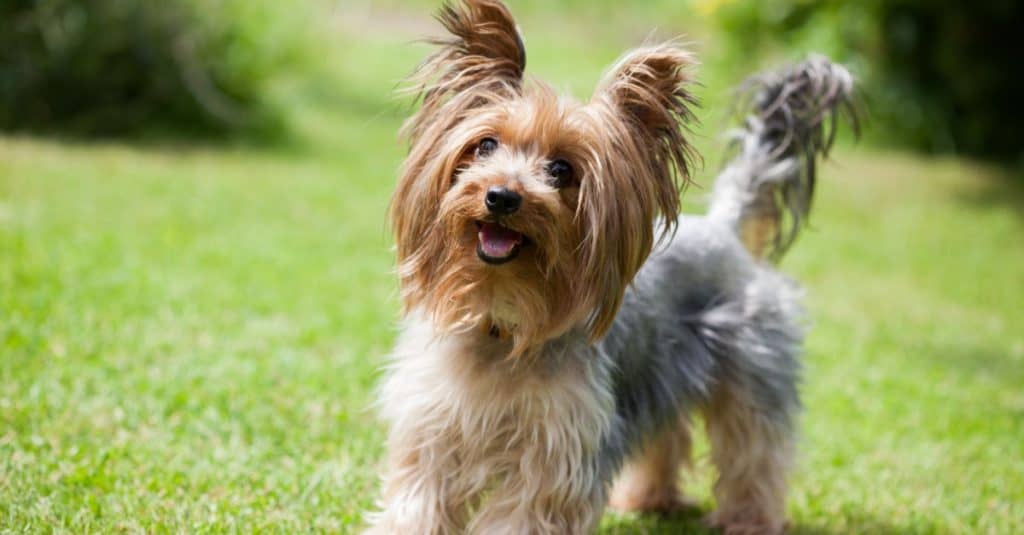
Yorkshire terriers were originally bred to hunt rats and other small vermin in the working mills.
©Birute Vijeikiene/Shutterstock.com
There’s no pup out there quite like the Yorkshire terrier! Yorkshire terriers, or Yorkies, may be small in stature, but their confidence is big enough to fill a room. With their silky coats and glamourous hairstyles, it’s no wonder Yorkies are so impressed with themselves!
However, there is more to the Yorkie than meets the eye. Scottish workers brought the Yorkshire terrier to England during the Industrial Revolution. There, they likely bred their Clydesdale terriers with smaller terriers in the area. The resulting breed was likely bred with other small terriers, eventually creating the Yorkshire terrier we know and love today.
The original Yorkshire terriers were created to hunt mice and other small vermin in the working mills. This likely contributed to their fierce and headstrong personalities today. They can be a bit spunky and even yappy at times. However, they are also extremely affectionate with their owners. They grow very attached to those they love and are happy to provide loyal companionship!
Yorkshire Terrier Growth and Weight Chart by Age
You won’t have to keep up with any major growth in your Yorkshire terrier. Still, it’s helpful to have an idea of how much he will grow in the first chapter of life. To inform you of what lies ahead for your beloved Yorkshire terrier, let’s break down the month-to-month growth timeline.
| Age | Male and Female Weight |
|---|---|
| Birth | 3-5 ounces |
| 1 Month | 10-14 ounces |
| 6 Weeks | 11-15 ounces |
| 2 Months | 1-1.5 pounds |
| 3 Months | 1.5-2 pounds |
| 4 Months | 2-2.5 pounds |
| 5 Months | 2.5-3 pounds |
| 6 Months | 3-4 pounds |
| 7 Months | 4-5 pounds |
| 8 Months | 5-6 pounds |
| 9 Months | 6-8 pounds |
| 10 Months | 6-9 pounds |
| 11 Months | 7-10 pounds |
| 12 Months | 7-11 pounds |
| 2 Years | 7-12 pounds |
Weight can vary slightly when comparing males and females. However, this weight difference is much more subtle than it is in medium or large breed dogs.
When Will My Yorkshire Terrier Stop Growing?
As a Yorkshire terrier parent, you will want to know when your canine companion will stop growing. The Yorkshire terrier is considered a toy breed pup, so this means your puppy will complete the majority of his growth by the time he reaches 10 to 11 months of age. Though your pup will likely fill out slightly in the following six months, you should be able to identify his mature size at 10-11 months old.
To ensure that your puppy is growing at a healthy rate, we suggest having him assessed by your veterinarian regularly. A six-month vet checkup, along with annual exams, are one of the easiest ways to ensure that your Yorkie is hitting his developmental milestones.
How Big Will My Yorkshire Terrier Be When It’s Fully Grown?

An adult Yorkshire terrier will typically weigh anywhere from seven to 12 pounds.
©Anna Vasiljeva/Shutterstock.com
The Yorkshire terrier is known for packing a huge attitude into a tiny body! So, just how small is the average Yorkie? Every Yorkshire terrier will vary slightly, but most will weigh anywhere from seven to 12 pounds when fully grown.
Your dog’s adult size will vary based on genetics. Meeting the parents is the best way to understand how big she may grow. This is one of the many reasons why it is essential to see your Yorkshire terrier’s parents in person, as it can offer you the best peek into her future.
When Should My Yorkshire Terrier Stop Eating Puppy Food?
A healthy and balanced diet is essential for the growing Yorkshire terriers in our lives. A growing dog needs extra support as he navigates puppyhood, and this is achieved through a high-quality puppy food. An ideal puppy diet for Yorkshire terriers has extra calories per cup to support fast metabolism. It also has additional calcium to support bone growth, along with added vitamins for healthy brain development.
Yorkshire terriers should be fed a puppy diet until they have completed the majority of their growth. This means you should feed puppy food until he has reached 10 months of age. You can transition your Yorkshire terrier to an adult diet for small breed dogs once he is 10 months old.
When Will My Yorkshire Terrier Start Losing Teeth?
Did you know that puppies lose a set of baby teeth just like people do? The timeline in which they lose their baby teeth is unique, but the process paves the way for a full mouth of permanent dog teeth!
Your Yorkshire terrier’s puppy teeth will start to grow when she is just under one month of age. These puppy teeth will begin to push through her gums for the next two to three weeks. They lead to a full mouth of puppy teeth by the time your Yorkie is six weeks old.
These sharp puppy teeth will stick around for the next month. However, you will notice them begin to fall out one by one as your Yorkie reaches three months of age. Eventually, by six months of age, these adult teeth push out all puppy teeth. Your six-month-old Yorkie should have a full set of permanent, adult pearly whites!
When Should I Start Training My Yorkshire Terrier?
The Yorkshire terrier is known for having quite a bit of attitude. This can be challenging to manage if you do not offer basic obedience training. You may think a small dog is easy to manage no matter how feisty he is, but a Yorkie that lacks training can participate in many undesirable behaviors. An untrained Yorkie can be yappy, destructive, and even prone to biting.
We suggest training your Yorkshire terrier from the moment he enters your home to prevent any unwanted behaviors. Most Yorkie puppies will be open to positive reinforcement-based obedience training from two months of age and on. The sooner you implement basic obedience training, the sooner he will catch onto potty training and socialization!
What Commands Should I Teach My Yorkshire Terrier First?
If you are just diving into your Yorkshire terrier’s training journey, then you may be wondering which cues you should start with first! While every family will have their own training priorities, here are a few commands we suggest starting with:
- Sit
- Stay
- Come
- Lay down
- Drop it or leave it
It’s important to factor in socialization as well. A Yorkshire terrier that’s afraid of the world may struggle with bothersome barking or aggression, and nobody wants that for their furry friend!
An ideal socialization plan should involve meeting new people (in and outside of your home) and new furry friends. It should also involve exploring new places. Just be sure to fully vaccinate your Yorkie before you start this socialization process. They can be exposed to infectious illness when meeting unfamiliar pups.
When Should My Yorkshire Terrier Be House Broken?
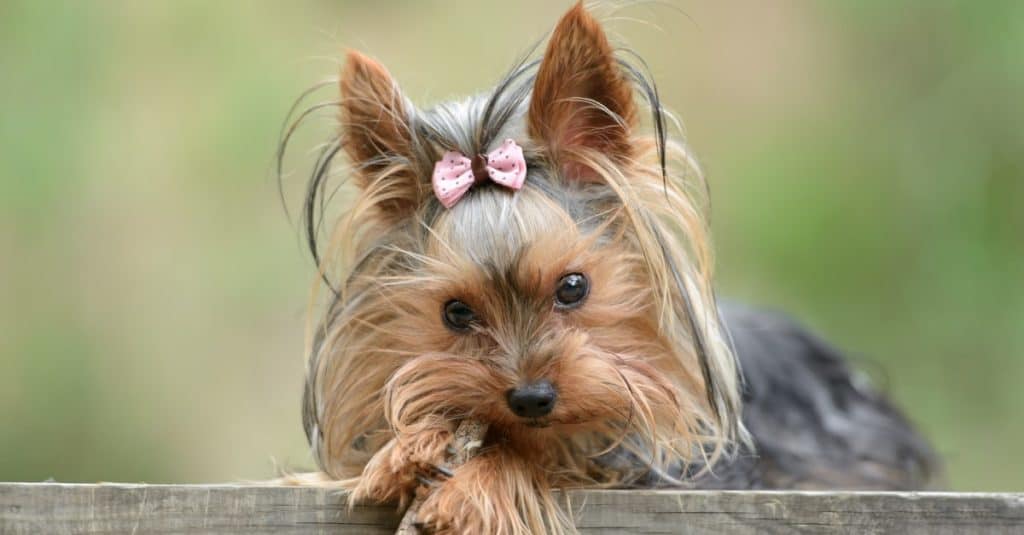
©tsik/Shutterstock.com
Housebreaking your Yorkshire terrier requires patience and consistency. Yorkshire terriers are fairly easy to train overall, but potty training can take a bit more time due to their tiny bladders and difficulty in holding their urine for extended periods. Potty training will always be a bit more challenging in small breed dogs, but with positivity and consistency on your side, you can do it!
A few keys to success when housebreaking your Yorkie includes maintaining a set feeding schedule, taking her outside multiple times throughout the day, and remaining consistent with your training. The Yorkie does especially well with positive reinforcement and praise, so this means you will need to offer plenty of treats and love! When following this guidance, your Yorkshire terrier will be potty trained within three to six months.
When Should My Yorkshire Terrier Be Spayed or Neutered?
There are many decisions you will need to make throughout pet parenthood, and the best time to spay or neuter your pet is one of them! We know you want to make the best health decisions for your little one, so let’s help you better understand the ideal time to spay or neuter your Yorkshire terrier.
Male and female Yorkshire terriers reach sexual maturity at around six months of age, so it is safe to sterilize them from this point on. Most veterinarians agree that the best time to spay or neuter your Yorkie is between the age of six months to one year, as this is the best timeframe to prevent future reproductive complications, while also limiting behavioral issues from reproductive hormones.
Ultimately, it’s best to work with your vet to make the right decision for your growing Yorkshire Terrier. Your vet will know what’s best for your little one!
Common Health Issues Seen in Yorkshire Terriers
We want your dog to live a long and healthy life at your side, which is why it is so important to be aware of any breed specific health issues. You may not always be able to prevent these common health threats but spotting them early on can increase the likelihood of proper management. Let’s break down the common health issues seen in our treasured Yorkshire terriers.
Hypoglycemia: Hypoglycemia in dogs refers to a dangerously low amount of glucose (sugar) in the blood. Glucose fuels a variety of vital body functions, so it is very dangerous if these levels drop rapidly. Hypoglycemia commonly occurs in Yorkshire terriers when they do not eat enough food each day, or if their meals are too infrequent throughout the day. Hypoglycemia in Yorkies can lead to disorientation, wobbly gait, muscle tremors, seizures, and collapse. This is a medical emergency that requires immediate intervention.
Patellar luxation: Patellar luxation refers to a misalignment of the dog’s knee joint. This causes the kneecap to become unstable, often allowing the kneecap to move out of place during activity. Not only can this be uncomfortable as it occurs, but it can cause serious damage and arthritis to the knee joint over time.
Liver shunts: Liver shunts, or portosystemic shunts, occur when there is an abnormal flow of blood between the liver and the body. The liver plays a major role in detoxifying blood that runs through it, so when blood flows out of the liver improperly, this allows unfiltered toxins to enter the bloodstream. This often leads to chronic GI upset, weight loss, inability to gain weight, neurological symptoms, and seizures. Liver shunts will always require some form of treatment or management option.
Collapsing trachea: Collapsing trachea occurs when the rings of cartilage in the trachea become lax over time. This can eventually cause the trachea to collapse on itself, making it challenging for the dog to breathe properly. This can drastically impact the Yorkie’s quality of life if it is not addressed properly.
Are Yorkies High-Maintenance?

Yorkshire Terriers’ coats require frequent brushing, bathing, and grooming.
©Srdjanns74/iStock via Getty Images
Feisty Yorkies are considered a high-maintenance breed, mostly due to their personalities and grooming needs. While their temperament is loved by many pet owners, some consider them too boisterous and a bit bossy. Get ready for a playful and affectionate pup! At times they can be sensitive and slightly moody, so they may not be suited for a home with young children, though older children and adults make perfect companions. A Yorkie’s human, however, will need to give ample time and attention to its coat. Their coats are very similar to human hair and require daily brushing to prevent matting. Frequent trips to the groomer are also necessary to maintain manageable length.
Pictures of Yorkshire Terriers as Puppies

Yorkshire terriers are spunky, goofy, and very playful!
©Pelevina Ksinia/Shutterstock.com
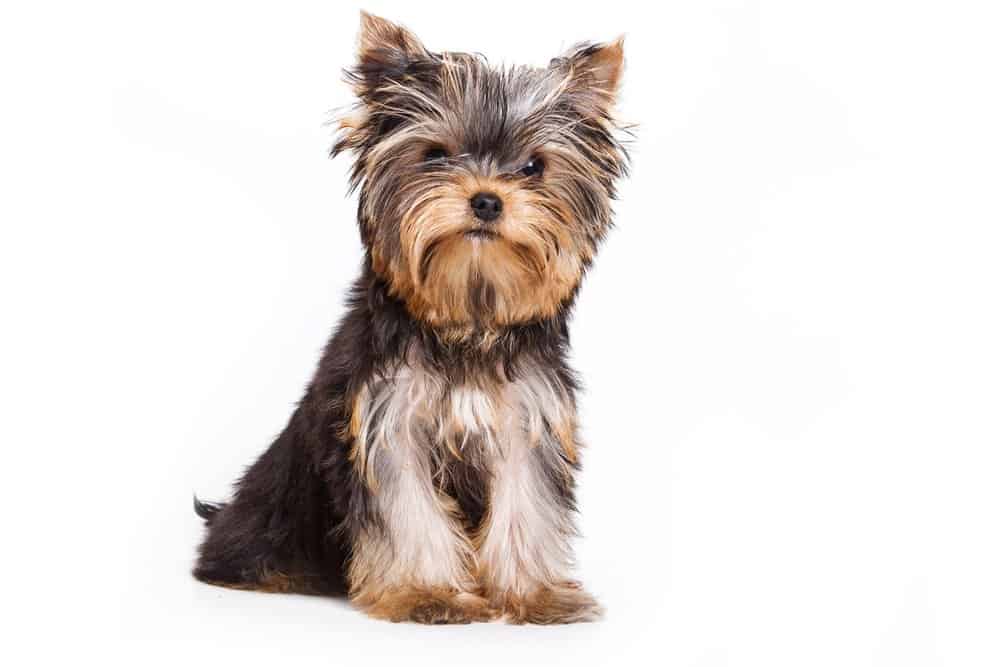
Yorkshire terriers become very attached to those they love!
©Utekhina Anna/Shutterstock.com
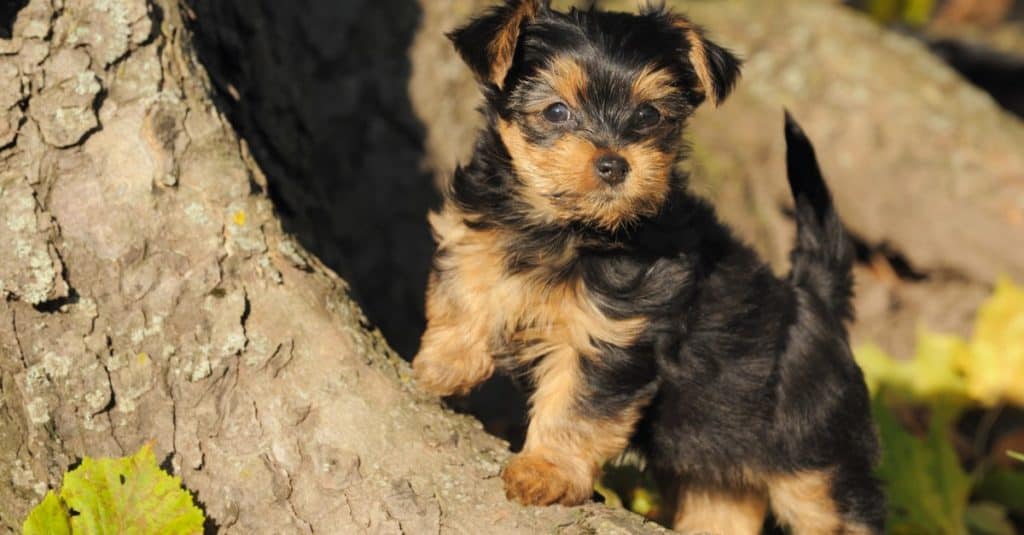
Yorkshire terriers will start to lose their baby teeth around 12 weeks of age.
©anetapics/Shutterstock.com
Pictures of The Yorkshire Terrier at 6 Months
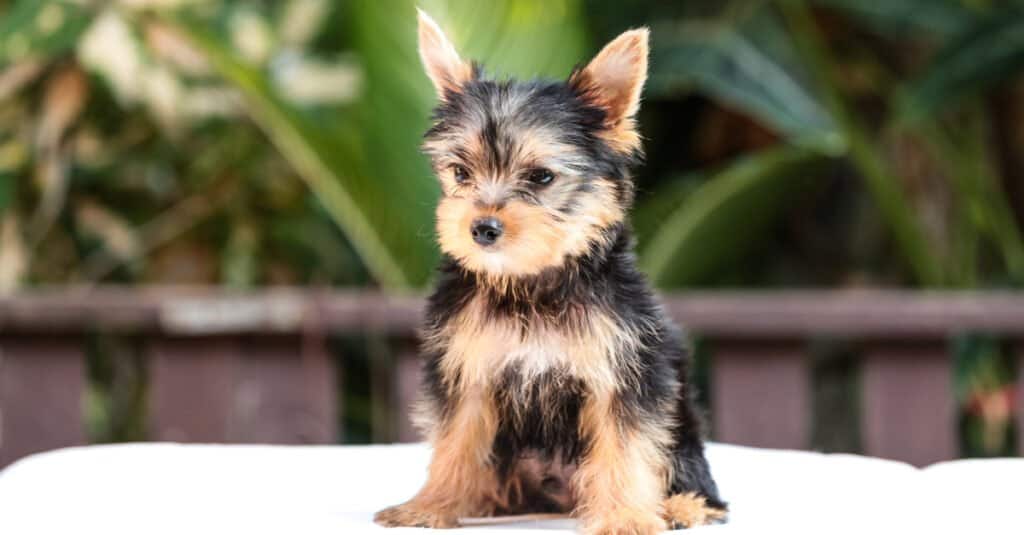
Yorkshire terriers require consistent and positive training to help them thrive.
©DOPTOON/Shutterstock.com
Pictures of Fully Grown Yorkshire Terriers
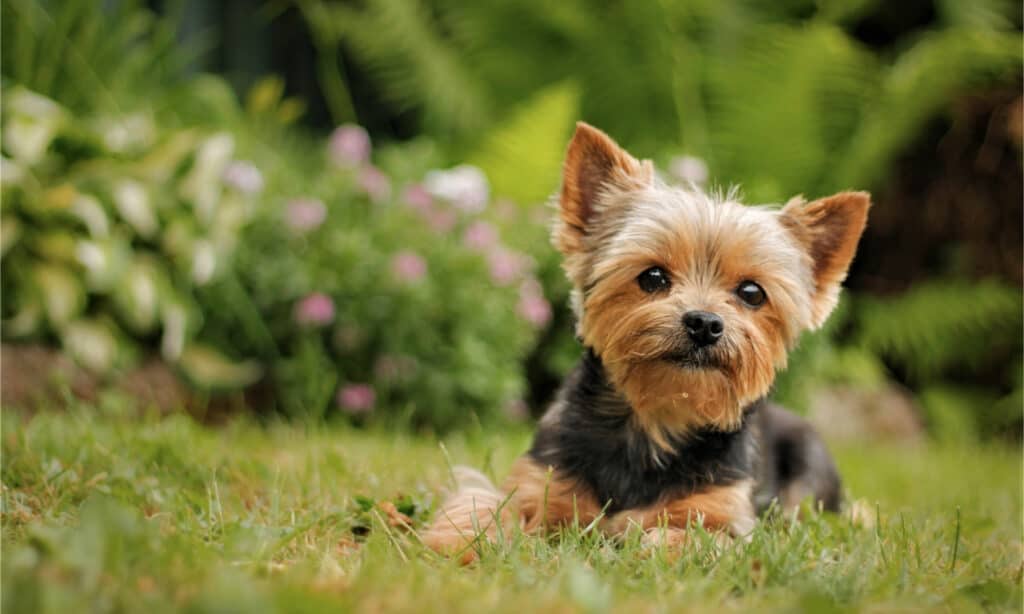
The Yorkshire terrier does not like being alone, so they need plenty of attention each day!
©Shllabadibum Bubidibam/Shutterstock.com
Are you ready to welcome an adorable Yorkshire terrier into your family?
The photo featured at the top of this post is © iStock.com/Attila Fodemesi
Ready to discover the top 10 cutest dog breeds in the entire world?
How about the fastest dogs, the largest dogs and those that are -- quite frankly -- just the kindest dogs on the planet? Each day, AZ Animals sends out lists just like this to our thousands of email subscribers. And the best part? It's FREE. Join today by entering your email below.
Thank you for reading! Have some feedback for us? Contact the AZ Animals editorial team.







